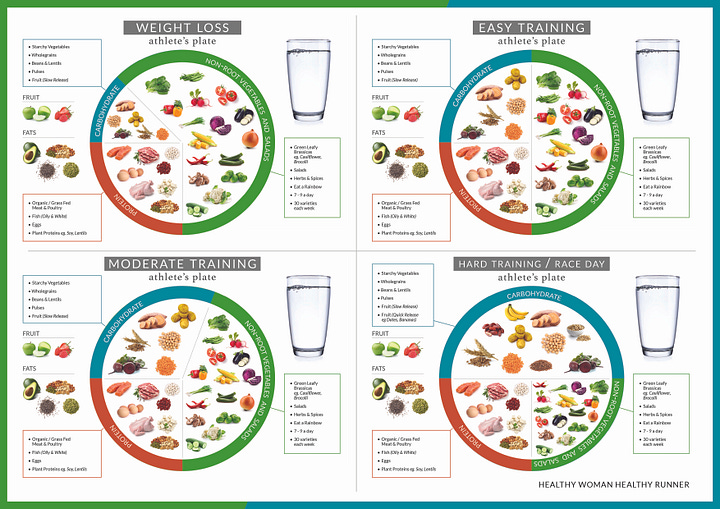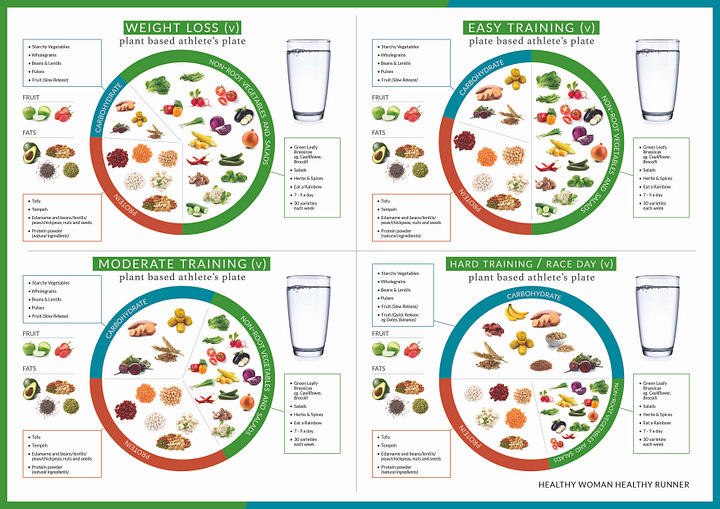Athlete's Plates are Simpler (and Smarter) Than Counting Calories or Macros
Athlete’s Plate balance is not a game of ‘who can pile the most carbs on their plate'
"There was a time when my meals were mostly carbs, with very little protein." It was no surprise I had energy spikes and crashes, often feeling sluggish during my runs.
Then I flipped to the other extreme(trying to lose weight): "I filled my plate with 75% veggies and 25% protein, cutting out carbs completely." But this left me struggling with recovery, heavy legs, and low stamina.
Fast forward and I’ve learned that balance is key. By including protein, carbs, healthy fats, and veggies, I feel stronger, recover faster, and have more consistent energy for my runs. Balance truly is everything when it comes to fuelling your body.
Perhaps plate balance would be better described as plate proportions – it’s not enough just to include protein, carbs, healthy fats, and veggies – it’s important to have each food group in the correct ratio and portion size for the level of activity and training you are undertaking.
Some people like to calorie count or macro count for precision but that feels like hard work to me. There is a danger that these approaches may lead to an overemphasis on numbers rather than the quality and variety of foods consumed.
Tracking your energy intake—whether through structured methods or intuitive approaches—can help ensure you’re eating correctly for your training and overall health.
"Athlete's Plates make life so much easier!"
As a runner, I prefer to use the Athlete’s Plate method for managing portion sizes and nutrient balance. It’s a simpler, more intuitive way to ensure you’re fuelling effectively without the burden of constant tracking. However, there are times when using food tracking methods can be helpful—particularly when learning about food composition or fine-tuning your nutrition strategy.
The Athlete’s Plate is a visual tool created by the University of Colorado/Colorado Springs (UCCS) Sport Nutrition Graduate Program, led by research scientist Nanna Meyer in collaboration with the US Olympic Committee’s (USOC) Food and Nutrition Services. The concept is to help athletes choose the correct balance of food groups to support their training level.
Alongside my good friend, fellow nutritionist, and former business partner Karen Campbell, we adapted the UCCS plate concept to create the Healthy Woman Healthy Runner Athlete’s Plates. We wanted to help women of all ages fuel their running and focus on balancing blood sugar for hormonal health, energy, and to have a healthy body composition.


Choosing an Athletes Plate in line with your training
There are four Healthy Woman Healthy Runner Athlete’s Plates (including a version for plant-based eating) designed for: ♦ Easy training ♦ Moderate training ♦ Hard training ♦ Weight loss. You can read more in my book EAT TO RUN.
Eating this way helps you to focus on nutrient balance rather than strict calorie or macro counting and has several advantages:
More Energy – the right mix of carbs, protein, and fats keeps you fuelled all day.
Faster Recovery – helps muscles repair and refuel after tough workouts.
Hormonal Balance – supports stable blood sugar.
Easy to use– no need to track every bite—just follow a simple visual guide.
Great Health –minimise infections, illness and protect against injury.
A Balanced Approach to Tracking
I do use some food tracking apps, but I don’t rely on them all the time. One of my favourites is ATE, which functions as a photo journal to encourage self-reflection and build healthy habits. Occasionally, I use MyFitnessPal to check on my energy intake and macros, but only for short periods (2-3 weeks) as I don’t find long-term tracking beneficial.
What's Your Athlete's Plate Balance?
Find out how well you’re balancing your plate!
Which food group leads the race on your plate?
a) Carbs
b) Protein
c) VeggiesWhat is the look of your plate at the dinner table?
a) Carbs cross first, protein follows, veggies cheer from the sidelines.
b) Everyone’s in a perfect lineup, playing nice.
c) Protein takes the lead, carbs are trailing, veggies are just happy to be there.When you think about your plate, you say:
a) "It’s a pasta party at every meal!"
b) "Balance is key—protein, carbs, fats, and veggies, all invited."
c) "Colourful Veggies for life, but sometimes I’ll let carbs and protein tag along."Your plate is most likely to be:
a) A carb-loaded sprint with an occasional protein pit stop.
b) A well-coordinated relay team of all food groups.
c) Veggies leading the way, with a little protein and carbs in tow.
Results:
Mostly A's:
"If my plate was a race, carbs would be in the lead."
Looks like your plate’s running a carb marathon—great for race day! But maybe it's time to let protein and veggies join the training sessions for a more well-rounded squad.
Mostly B's:
"My plate’s like a party—everyone’s invited, but they have to play nice."
Your Athlete’s Plate is the nutrition equivalent of a gold medal performance! You’ve got all the right players, and they’re all playing nicely together. Keep it up, you are a winner!
Mostly C's:
"Veggies are clearly your Most Valuable Player—maybe they’re even the coach!"
Now, let's get protein and carbs in the game to avoid turning your plate into a salad-only race. Time for a full team effort!
A Stress-Free Way to Fuel Your Running
If you’re a runner looking for a sustainable approach to fuelling, consider using Athlete’s Plates as a flexible, stress-free alternative to calorie or macro counting. It allows you to focus on nourishing your body while keeping the process simple and effective.





